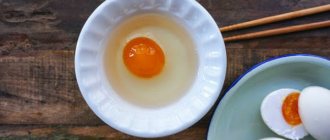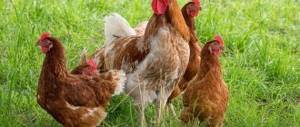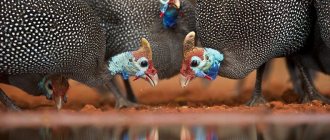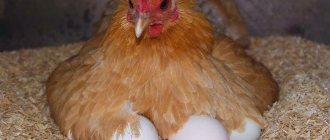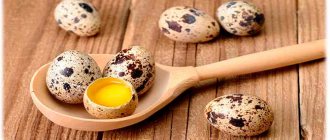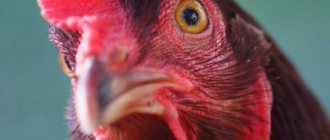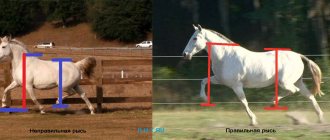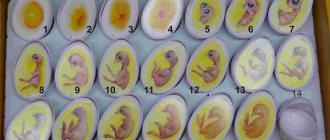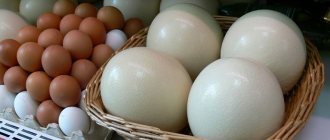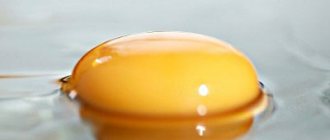Poultry farming » Chickens
0
1790
Article rating
Kira Stoletova
Breeding poultry requires the farmer to have maximum knowledge about the characteristics of the species. How does a chicken lay eggs? We will analyze in detail the physiological subtleties of the process that will help increase the productivity of pets and we can see all this in the video.
How a chicken lays eggs
Features of formation
Unlike wild ones, domestic chickens lay eggs not only when it is necessary to breed. Compliance with certain rules will allow you to get up to 300 units per year from one individual. However, new farmers may make mistakes that impair productivity.
How does the corydalis fly? A huge number of cells are formed in the ovaries of the female, which are at different stages of development. The ripe element leaves the follicle and gradually moves into the oviduct. The yolk is “overgrown” with white and shell. The entire process lasts approximately 20 hours.
After the hen has produced an egg, the reproductive organs will release another cell. On average it takes from 30 to 40 minutes. The presence of a rooster does not affect performance. Females lay eggs in any case, even if he is not there, only such specimens cannot produce chicks. To obtain hatching material, one male is needed for every 10 or 15 individuals.
Interesting facts about eggs
Ice Easter Egg
In Moscow in 2010, an ice Easter egg was cut out for Easter (its weight is 880 kg, height - 2.3 m).
The average hen lays about three hundred eggs per year.
Almost 570 billion chicken eggs are eaten every year.
The world's largest producer of chicken eggs is China (160 billion pieces).
Chocolate eggs
It’s impossible not to mention the “Kinder Surprise” chocolate eggs with a colorful toy inside, beloved by several generations.
Every year, on the second Friday of October, an international holiday is celebrated - World Egg Day.
An egg against a red square background is the MTS logo.
As you know, advertising is the engine of trade. In Japan, labels advertising instant noodles were placed on eggshells.
Egg Monument, Canada
There are (and in more than one country) monuments to eggs. Thus, in Vergenville (Canada) you can see the largest Easter egg monument - its height is about eight meters.
The chicken eggs that go to our table are unfertilized eggs (or “scrambled eggs”). Chickens can carry them without the help of a rooster.
Egg structure
The product is an amazing creation of nature. It is created for the formation and development of chicks, so all the necessary substances are concentrated in it.
- Yolk. This cell contains a huge amount of carotenoids and accounts for at least 30% of the total volume.
- Protein. It will be a nutritional medium for the baby, representing a protein-fat mass with carbohydrates. Occupies approximately 60% of the egg size. The natural antibiotic lysocin protects the product from spoilage.
- Shell. A natural shield protects against destruction. Makes up to 15% of the total volume.
The chick is formed in the yolk over the course of a month, so it is enclosed in a durable shell. The protein ropes will fix the element well in the middle of the protein mass, and the embryo can easily turn around its axis. At the blunt end of the egg there is an air chamber for gas exchange because there is no direct access to oxygen.
How are double-yolk specimens obtained? Two cells can simultaneously enter the female's reproductive tract. Next comes the formation according to the natural plan. Most often, broilers and old laying hens that have been laying eggs for a long time are prone to this pathology.
There are a few breeds in which this deviation is cultivated. Hormonal imbalance leads to changes in natural productivity and is therefore dangerous. The eggs become stuck inside the bird, causing illness and death.
When they start rushing
At what time do birds mature and how do chickens lay eggs? It all depends on the characteristics of the breed. Egg-bearing species begin 120-140 days after birth, and meat-bearing species begin at the age of no earlier than 8 months. Representatives of the mixed type will delight farmers after six months.
Pullet products can be recognized visually. Often the first copies are very small and the process does not have a stable periodicity. If the owner was fond of using hormonal drugs, then the young hen will lay an egg with two yolks. During this period, “fat” samples are possible - solid protein.
We must remember that physical maturity in these breeds occurs at the age of 145 days after birth, so there is no need to worry. During this period, it is necessary to improve the diet of the corydalis and create optimal living conditions. After 3 weeks they should adapt and the failures will stop.
The structure of the bird's body
The reproductive system of roosters consists of testes, which are located near the kidneys. During mating they increase in size. The testes continue with the spermatic ducts, at the end of which there is a seminal vesicle that contains sperm. Birds do not have external genitalia. In a laying hen, the left ovary, which is also located near the kidney, is considered more developed. It continues with the oviduct, which opens into a special tube connected to the cloaca, the posterior part of the digestive canal, which connects to the reproductive ducts. The oviduct has two sections: the fallopian tube and the uterus.
The process of egg appearance in domestic and wild birds follows the same pattern, which is laid down by nature at the genetic level.
The structure of the genitourinary system of chickens
Sexual maturity in roosters and hens
Hens begin producing eggs when they reach sexual maturity.
Puberty in chickens and roosters occurs simultaneously.
The specific time is determined by the breed of the laying hen. Young birds of the egg breed can lay eggs within 17-20 weeks; meat and egg breeds begin to produce the product no earlier than six months. Meat individuals lay eggs no earlier than 8 months after birth.
Sexually mature individuals
A distinctive feature of birds ready to produce eggs is their bright red comb. Juveniles that are not ready to roost are distinguished by a small crest of a pale pink hue. A productive laying hen can be identified by its appearance - it is medium-sized, has dense bones, its plumage is well developed, its wings are massive, and its comb hangs to one side. A good laying hen also has a large and soft belly.
The onset of puberty in chickens of different breeds
| Chicken category | Onset of puberty |
| Egg breeds (Russian White, Leghorn, Minorca, Andalusian, Hamburg and others) | 17-20 week |
| Egg-meat breeds (Kirghiz gray, Barnevelder, Ukrainian Chubataya, Tsarskoye Selo and others) | 5 months |
| Meat breeds (Cornish, Mechelen, Dorking, Langshan, Brahma and others) | 8 months |
The onset of sexual maturity depends not only on the age of the bird, but also on the diet. If you feed the chicken correctly and carefully care for it, the laying hen will begin to bear fruit on time. Sexual maturity also depends on the time of hatching. Winter chicks or those hatched in early spring begin to lay eggs earlier than their counterparts.
Rooster and hen
Sexual intercourse in chickens
In each flock there is one leader - the strongest and strongest rooster. When a laying hen molts, the male does not pay attention to her; on the contrary, he chases the female and ignores her. But as soon as the molting ends, the male begins to walk around the hen he likes and scratches with his lowered wing. The rooster shares the spoils with the hen, thereby showing his attention. During the mating process, the male holds the hen by the back of the head with his beak, saddles her and makes several rapid movements (trampling).
Roosters are capable of mating 10 to 50 times a day - it all depends on the specific breed.
Mature roosters
The rooster's cloaca turns outward and meets the partner's cloaca. The seed, which is secreted by the sex glands of the rooster, penetrates inside the female, into her genitals. Moving through the chicken's body, sperm move into the egg, and the egg is fertilized. The seed can remain active in the chicken’s body for up to 20 days - all eggs that will be produced during this period are fertilized.
Placing an egg in front of a light source can help determine whether chicks are to be expected. Look carefully at the product - if you see a clearly visible dark spot (embryo), the egg is fertilized.
Mating process between hen and rooster
Video - How does a chicken lay eggs?
Characteristics of laying hens
How to identify a female with good productivity at home? Such chickens have practically no maternal instinct. They can lay up to 300 specimens per year, but will never try to cluck or will “escape” from the clutch after a couple of days. The price of high productivity is the absence of the desire to procreate.
In order for chickens to lay eggs well, they must have a number of characteristic features:
- weight does not exceed 2.5 kg;
- well-developed bright lobes and comb;
- light skeleton;
- wide wing span;
- compact dimensions;
- increased mobility;
- early maturation (at 4 months).
It is important to remember that record holders quickly deplete their productivity. Egg production requires a lot of effort from the bird, and every year it decreases by 10%. To prolong the process, experienced farmers are organizing enhanced nutrition and increasing daylight hours.
Breeds
Over many years of selection and work with chickens, geneticists have bred the ideal laying hen, so now you can choose a bird to suit your needs. Which of the presented varieties is the most productive? Let's look at the main favorites.
White Leghorn chickens are the most popular breed of domestic laying hens. Almost all modern specimens were obtained by crossing this species. Representatives of this “genus” pleased farmers with maximum fertility (up to 370 pieces per year) and egg size. They begin to lay eggs without interruption from the 17th week after birth.
The black Minorca chicken has a bright scarlet comb and white earrings. Despite its miniature and decorative appearance, the bird produces a large product in a dense shell - up to 80 g per specimen. Early maturation of young animals and good returns will allow the breed to be raised on any farm.
Andalusian blues will delight the farmer with a perfectly white and smooth medium-sized egg. Compact birds with an annual fertility of just over 160 individuals. undemanding to care and non-capricious, beginners will like them. Multi-colored Borkov chickens will surprise you with their giant brown produce.
Hybrids
Crosses have maximum impact, which is why they are popular among professionals and amateurs. As with plants, acquired qualities are not passed on to the next generation. Hybrids are obtained through complex breeding work.
Brown Sussex Star and Nova chickens produce a large number of eggs, the color of which can be either white or dark. The unpretentious cross Black Star can carry up to 270 copies in the first year of use. The red hybrid Tetra SL shows productivity at the age of five months.
By the way, breeding work does not stand still, and scientists are ready to surprise farmers with new results. Tailless Arakuna are characterized by the red color of the rooster and colored hens. But the highlight of the cross is the blue and blue eggs, striking in photos and videos. If they are crossed with a breed that produces brown-shelled products, the result will be hybrids with green and pink shells.
Nutritional Features
With the wrong diet, even the most productive cross will not be able to display all its characteristics. A beginner needs to know the intricacies of raising egg-laying breeds so that they lay well. Any mistake with chicks and adults will lead to irreparable results.
Feeding is carried out 4 times a day. More attention is paid to procedures in the morning and evening. Professionals advise giving not only feed and grain, but also wet mash. In order for birds to fly without problems and not peck at the shells, it is necessary to include mineral supplements with calcium and phosphorus.
If fed poorly during childhood, adult chickens will not display all the characteristics of the breed. Chicks will begin to have problems as their skeletons and feathers develop. To avoid trouble, it is better to feed protein containing food and cooking scraps (fish scales, entrails, ground animal bones).
How to make money on birds and eggs? Earning scheme
If suddenly you are not familiar with making money on birds and eggs (although I am sure that this is not the case), then here is a diagram explaining the essence of the game:
- After registration, the player buys birds (using bonus funds or funds deposited into the game). The more expensive the bird, the more eggs it will lay, and the more the player will earn. Usually the section where birds are purchased has names like “Store”, “Buy Birds”, “Buying Birds”. Immediately after purchasing the birds, the automatic accumulation of eggs will begin;
- Now you need to collect eggs in the “Egg Warehouse” section. You can collect them at any convenient time (once a month, day, hour), but, as a rule, no more than once every 10 minutes. In some poultry farms, the warehouse tends to be 100% full, then you need to go to the poultry farm every two days and collect eggs;
- Collected eggs must be sold through the system market (usually the name of the section is “Sale of eggs”), for this you will be credited with game coins or silver to your balance for withdrawal;
- Withdraw funds using any available method;
- Use, where provided, additional options and opportunities to earn more on eggs and birds. For example, you browse websites while surfing, complete tasks for payment, participate in an affiliate program, competitions, lotteries, etc.
Content Features
What can you do to ensure your bird reaches its full potential? According to the standards for 1 sq. m there must be at least 5 females. Cluttered content affects productivity. The number of nests also affects the herd. Farmers are required to make comfortable perches as needed for the entire family and provide them with warmth.
Lighting is another factor that affects egg quantity and quality. Birds need thirteen hours of daylight. Additional equipment is installed in the chicken coop.
Lighting should not blind the hen. If the chicken coop is designed in such a way that it receives a lot of direct sunlight, then you need to make protective curtains from burlap.
Chickens should be released into fresh air every day. Ultraviolet irradiation affects the absorption of vitamin D. When kept in pens, laying hens lose their productive abilities. During regular walking, you need to ventilate the chicken coop.
In order for birds to produce eggs better, you need to monitor the temperature. Cold and heat in the room affects the quality and quantity of products. It is optimally recommended to maintain heat at a level of 23 to 25°C. Oscillations in any direction are undesirable. In the summer heat, females often carry specimens without shells.
How a chicken lays eggs: description, process, video
When raising chickens, farmers inevitably have to learn a lot of new information. Feeding, setting up an enclosure, breeding issues - this is only a small part of what any experienced breeder knows by heart. However, you should pay attention to another interesting process occurring in the body of chickens. How does a chicken lay eggs? At first glance, everything is quite simple, however, this process of the life of chickens has its own nuances, which you simply need to know about.
How do eggs come out?
The physiological transformations that result in a chicken laying an egg are inherent in her body at the genetic level. Wild individuals, whose descendants delight our eyes today on poultry farms, bred in the same way for many years.
However, there is a significant difference between our chickens and their ancestors: chickens living freely in nature had almost no problems with reproductive functions. The fact is that modern laying hens are expected to constantly update their nests, while the “savages” only needed to acquire chickens to continue their kind.
How much product can a healthy chicken produce in a certain period of time? Where do the valuable chicken fruits come from? The ovaries of females contain a certain number of eggs, varying in degree of development.
They mature in the follicle, from where, having finally turned into yolk, they enter the oviduct. Over the next 20 hours, a protein and protective shell grows on the egg.
According to experts, one healthy laying hen per year can bring the farmer approximately 300 units of quality product, which can subsequently be sold profitably. This is why it is important for farmers to know how chickens lay eggs.
But what happens after the laid fetus leaves the oviduct? After about half an hour, a new egg enters it, and everything described above begins again. It is not uncommon for an egg to have two yolks instead of one. Why might this happen?
This is explained by the fact that a pair of eggs entered the genital tract at once. It may also be that an additional yolk comes out after the first one, then it will lack a shell. An unfertilized product, in which there is no yellow center, is generally called dietary. This will work if there is no rooster in the chicken coop with the laying hens.
Features of oviposition
The moment when the process of puberty of a laying hen is completed and she is ready to perform her primary function can come at different times. For the most part, everything depends on the breed of the individual; for specifically egg-laying chickens, the first receipts of the product can be expected after reaching the age of 18–20 weeks.
A chicken belonging to the meat-egg breed lays eggs only after 6 months. Meat breeds of birds require even more time - from 8 months or more.
Experienced farmers go to great lengths to ensure that their chickens lay eggs more productively and that the eggs themselves are of higher quality. The main attention, of course, is paid to the diet of the inhabitants of the poultry farm. By controlling the balance of nutrients and beneficial elements in the birds' feed, their health is primarily maintained.
Often a deficiency of some important mineral element occurs in the body of chickens. Here vitamin complexes will come to the rescue, which can be purchased at any pet store.
The main thing is to choose the right drug so that, along with the necessary substances, substances that they do not require at all do not enter the body of laying hens. In addition to nutrition, there are other small factors to consider:
- lighting and temperature in the chicken coop;
- availability of a convenient walking area;
- comfortable nests, etc.
If you take into account all the nuances, you can ensure that the chickens ultimately produce a high-quality product.
Learning new things about how chickens lay eggs, novice farmers often come to another logical question: for how many years can a laying hen perform its main function? It is known that the inhabitants of specialized poultry farms remain fertile for an average of 2 years. Why exactly this period?
The reason is that by producing about 250–300 units in 12 months, the hens will become significantly weaker. Their body becomes depleted over time, causing the ability to bear new fruits to disappear at one point. There are other factors that influence how long an individual remains fertile, but their influence is not as significant.
In young female chickens that have just completed the process of puberty, the first eggs are often small in size, and so-called fatty eggs consisting only of protein may appear in their nests. The explanation is simple - protein has accumulated in the oviduct of young individuals, on which a shell has grown. Over time, such cases will be reduced to a minimum, and healthy layers will begin to produce consistently high-quality products.
It is also impossible not to mention the problem that owners of chicken breeding farms often face. It lies in the fact that birds lay eggs that are not covered with a shell. Instead, a leathery film forms on the fruits, which is a sign of malaise in laying hens.
As a rule, such negative changes are associated with insufficient levels of substances necessary for their health, such as calcium and phosphorus, in the birds’ bodies.
You can compensate for their deficiency with the help of vitamin preparations containing these elements.
What happens when the hormonal levels of laying hens are disrupted? In this case, after domestic chickens lay eggs, bloody spots can be observed in the eggs they produce. This is all due to the fact that due to illness, the reproductive system begins to function incorrectly, and the covering of the follicles in the genital tract ruptures ahead of time.
Why do such troubles happen? Hormonal imbalances often appear when chickens contract viral diseases. All that is needed to avoid unpleasant consequences and protect the body of laying hens is a course of treatment and a properly balanced diet.
Why is there a rooster in the chicken coop?
Having learned how a chicken’s egg comes out, how much production the female produces per year, and how long she can continuously produce a high-quality product, farmers ask another reasonable question. Having created all the necessary conditions for the life and reproduction of laying hens, how can we ensure that they lay fertilized eggs from which viable offspring can hatch?
To accomplish this task, the farmer places a rooster in the chicken coop, because it is he who will help the females correctly perform their reproductive functions.
In general, everything is quite simple - eggs laid by a laying hen in the absence of a rooster will not hatch into chickens. Without a male, hens lose their instinct to hatch eggs, so only the presence of a male induces hens to warm the contents of their nests.
Experts unanimously declare that the presence of a rooster in the poultry house is necessary, since it teaches laying hens to walk in a flock. On farms where meat breeds of chickens are raised, chickens are a valuable resource, so hens cannot do without a “man in the house.” So, in any case, it’s not worth giving up such a useful neighbor for laying hens.
What are the benefits of chicken eggs?
This nutritious product should be eaten daily by every person. There are many ways to prepare this product - people have tried to use eggs in cooking in different ways since ancient times.
But the main distinguishing feature is their composition, which contains as many as 12 vitamin elements necessary to maintain the health of the human body. These include substances of the main groups - from A to K, and in terms of vitamin D content, the yellow center of the egg is second only to fish oil.
The beneficial substances that a person receives when eating a chicken egg include:
- iron;
- iodine;
- calcium;
- phosphorus;
- magnesium, etc.
The presence of such a list of elements makes the product indispensable for people with diseases of the cardiovascular and nervous systems. Experts note a positive effect on the condition of bones and teeth, vision, as well as the fact that the growth process of muscle tissue improves.
Pregnant and lactating women should know that folic acid contained in chicken eggs is an extremely important chemical element. Why is this acid so useful during pregnancy? It promotes the proper development of the baby’s nervous system and brain.
In addition to women awaiting a new addition to the family, athletes and overweight people will receive significant benefits from eating chicken fruits. The product will fit well into a balanced diet, designed both for rigorous strength training and for weight loss.
Chicken breeds
As soon as humanity noticed what a valuable bird lived next to it, experiments began to breed new breeds, which led to the fact that at the moment there are three main breeds of chickens:
- meat chickens.
- egg hens.
- universal (combine types 1 and 2).
Every breed of chicken lays eggs, but those that are meat chickens lay them in much more modest quantities than egg-laying hens. The first breed of chickens lays about one hundred to one hundred and fifty eggs per year, but the second breed brings almost twice as much, two hundred to two hundred and thirty eggs in one year.
Egg hens are characterized by their small size, and they mature much faster, which allows them to start laying eggs earlier.
It is believed that the most egg-laying chickens are:
- Leghorn;
- Hamburg;
- Andalusian;
- Minorca and others.
Recently, hybrid chickens have become popular, which are considered more unpretentious, because there are no special requirements for their maintenance, which simplifies the procedure for their maintenance, and they lay ten percent better.
Proper nutrition for chicken
In order for the hen to cope with the tasks assigned to her and bear the maximum number of eggs, she needs to be given proper and timely nutrition. Particular attention should be paid in winter. A chicken lays eggs well if it receives sprouted grains. If you take corn or some kind of grain and place it in warm water for several days, you will soon see results. The temperature of the room in which germination will be carried out should also be quite high, about twenty-five degrees Celsius. As soon as the sprouts begin to sprout, this crop should be given to the chicken.
Another option for increasing the clutch is to add yeast to the food. A thirty-gram bag is poured into warm water, infused, after which a kilogram of grain, which has previously been crushed, is poured into the solution. The resulting mixture should be well mixed and left to settle. After eight or nine hours in cozy, warm conditions, the grain is ready for the birds to eat. This additive cannot be given to chicken in its pure form; it must be diluted with a mash.
To understand what reasons can influence how a chicken lays eggs, it is important to know them and be ready to overcome them. The main reasons for poor masonry:
- The period when a chicken moults;
- Incorrect temperature conditions, sudden changes in heat and cold will negatively affect the egg production;
- Some breeds of chickens are sensitive to cold and cannot lay eggs in such conditions;
- Various diseases also affect the number of eggs;
- Insufficient lighting will not allow the chicken to make the most of its body;
- Various situations that provoke stress in chickens.
The most favorable time, when the hen lays eggs as intensely as possible, is the time before molting. After molting, the number of eggs produced by one hen decreases by five to ten percent. There is no specific period for molting; it could be two weeks, or maybe several months. As soon as everything comes to an end, provided the bird is properly maintained, its egg production abruptly resumes.
A decrease in the number of eggs laid can be observed over time, because as a chicken ages, it stops laying many eggs. The quality characteristics of the egg also begin to fall, the thickness of the shell, its external integrity, all this may deteriorate. In addition, there may be various other pathologies, but all this over time, when the chicken becomes very old.
It happens that a chicken lays eggs that have two yolks, but this is normal, just leaving the oviduct, the yolks, one by one, unite and become covered with shells together, and not each separately. This phenomenon is short-term and goes away on its own.
If you want to have a stable number of eggs, then you need to bribe new young hens at certain intervals. For the most part, chickens lay eggs consistently for about ten years, so it is important to understand how often to bribe young chickens so that they have time to grow and lay eggs.
It is difficult to determine how many eggs each generation will have, because the number of eggs will be different for each generation. It will not be difficult for an experienced poultry farmer to track the laying trend of all chickens; he will immediately notice those who are no longer keeping up and replace them.
Looking at a chicken, it is difficult to immediately determine whether it will lay well or mediocre, however, by choosing the right variety and providing the necessary robbing conditions, you can independently bring the desired result closer.
Method of increasing egg production artificially
In the fall, the bird begins to molt and stops laying eggs. The process lasts about a month. To shorten the rest period, laying hens are closed for 1–2 days without water and feed. Then the bird is transferred to abundant, nutritious food, and the light regime in the chicken coop is extended. The method allows you to reduce productivity losses to a minimum.
However, the method is rarely used in households: there is an opinion that for the taste, nutritional and environmental value of eggs, birds need to rest. It is believed that record laying hens lay less tasty eggs than their companions with average egg production.
At what age do hens lay eggs?
Chickens are born with a supply of eggs that is enough for 15 years of her life (about 2-4 thousand). In the first year, the bird lays 1 egg every 1–2 days. The egg production of laying hens decreases with each passing year, so in practice, hens are kept on homestead farms for no more than 3–4 years. Then they are slaughtered for meat, since in older birds the meat becomes too tough and the number of eggs decreases.
But we can confidently say that with good care, the chicken will lay eggs for the rest of its life, no matter how long it lives. Sometimes individual individuals (good hens or simply favorites of their owners) are kept longer than the traditional three-year period. There are cases where chickens lived up to 18 years and laid eggs.
Improved Productivity
Many farmers have encountered a situation where birds “stop production.” How can you get chickens to lay eggs? There are proven folk methods that should correct the vagaries of nature.
It is necessary to reconsider the diet and choose a balanced professional diet. Grains, vegetables and herbs should form the basis of the menu. Mineral supplements, shell rock and bone meal are used to form the shell. It is important to check that the coop has easy access to fresh, cool water. Laying hens drink plenty of fluids before bed and after they produce eggs.
Each chicken has its own internal alarm clock, which brings it into periods of fertility and rest. To speed up the time it takes to receive products, farmers provoke molting in the herd. To do this, the livestock is put on a short-term diet, after which a lot of yeast-containing feed is added to the diet. Stress causes the corydalis to change feathers and they will soon lay eggs again.
Ways to solve the problem of egg production
If the reason for the lack of masonry is identified, all that remains is to take the necessary measures. Vitamin deficiency and lack of minerals are compensated for by organizing proper nutrition and purchasing additional supplements containing useful substances. Vegetables and herbs must be present in the menu of laying hens. Due to their absence in the spring, vegetation in the area where vegetation is allowed to range decreases or stops. The bird is fed at least three times a day and given grains in the morning. You can add granulated feed.
During the day, preference is given to wet mash, to which bran and white bread are added and filled with boiled water. Chalk must be present in the diet. It provides the bird's body with the necessary vitamins for the formation of the shell, since it contains a large amount of calcium.
Walking is important for chickens; if this cannot be done, then whole or chopped grass should be added to the feed during the day. The greenery should be varied, consisting of celandine bushes, nettles, milkweed, beet leaves, and pea waste. As soon as the laying hens receive the necessary vitamins, the clutch will recover.
When stressed due to a change of housing, birds need help to adapt to the conditions. Vitamins, herbs, and additional nutrition help overcome its consequences. If a new individual appears in the chicken coop, the laying hens will get used to it within a week.
In order for chickens to lay eggs well, they need to create favorable conditions. The optimal temperature for the poultry house where birds are kept is 15-23 degrees. If the room is hotter, then arrange regular ventilation. If it is cooler, then seal all the cracks to eliminate drafts, making the coop warm and dry.
In the fall, the room is prepared for winter: the walls are whitewashed with lime, cracks and holes are eliminated, heating and additional lighting are provided if possible. Another condition for productive laying is to provide free space for each individual; in crowded conditions, productivity drops.
Common problems
Beginners often encounter maintenance difficulties. What to do if a bird pecks an egg? Usually the disease affects one individual, but after a while the entire chicken coop becomes involved in sabotage.
If there are no errors in the housing conditions, then the reason must be sought in the regular feeding of eggshells to the livestock. Laying hens get used to the smell and sight of the product, so they use it as the main source of calcium. Once you try the white and yolk at least once, it will be difficult to stop you from committing a “crime.”
In crowded conditions, an aggressive female may appear that likes to feed on the protein mass of the nest. Many chickens follow their fellow tribesmen and adopt dangerous habits. It is recommended to observe the herd for a while and identify the culprit. Such an individual hangs around near places where birds were flying.
Knowing the characteristics of chicken reproduction, you can get the most out of a small flock. You learned how a complex process works and what needs to be done to avoid making common mistakes. The data will be useful to both beginners and experienced farmers.

